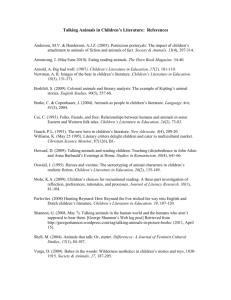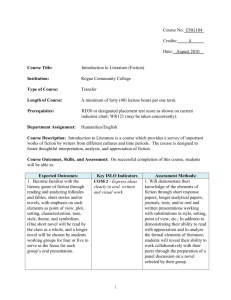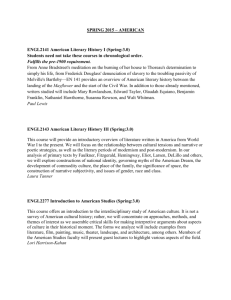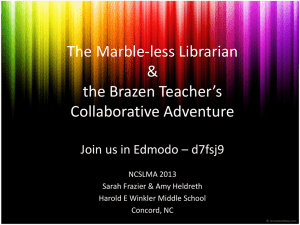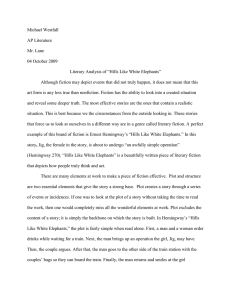literary analysis.doc
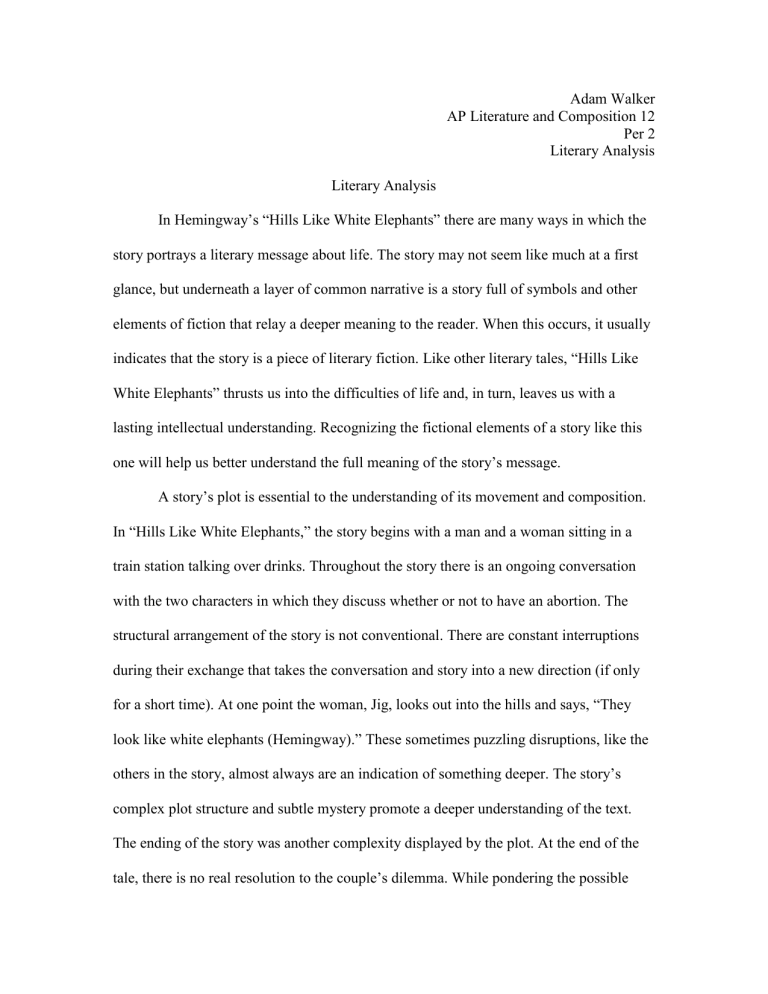
Literary Analysis
Adam Walker
AP Literature and Composition 12
Per 2
Literary Analysis
In Hemingway’s “Hills Like White Elephants” there are many ways in which the story portrays a literary message about life. The story may not seem like much at a first glance, but underneath a layer of common narrative is a story full of symbols and other elements of fiction that relay a deeper meaning to the reader. When this occurs, it usually indicates that the story is a piece of literary fiction. Like other literary tales, “Hills Like
White Elephants” thrusts us into the difficulties of life and, in turn, leaves us with a lasting intellectual understanding. Recognizing the fictional elements of a story like this one will help us better understand the full meaning of the story’s message.
A story’s plot is essential to the understanding of its movement and composition.
In “Hills Like White Elephants,” the story begins with a man and a woman sitting in a train station talking over drinks. Throughout the story there is an ongoing conversation with the two characters in which they discuss whether or not to have an abortion. The structural arrangement of the story is not conventional. There are constant interruptions during their exchange that takes the conversation and story into a new direction (if only for a short time). At one point the woman, Jig, looks out into the hills and says, “They look like white elephants (Hemingway).” These sometimes puzzling disruptions, like the others in the story, almost always are an indication of something deeper. The story’s complex plot structure and subtle mystery promote a deeper understanding of the text.
The ending of the story was another complexity displayed by the plot. At the end of the tale, there is no real resolution to the couple’s dilemma. While pondering the possible
Walker 2 outcomes, one may also think about the intricacies of life that resemble the story’s conclusion.
The characters in “Hills Like White Elephants” are just as complex and intricate as the plot. These characters’ complexities, therefore, give them three-dimensional qualities that often resemble a real human being. This element of literary fiction makes it easier to connect with the characters in the story and to remember them as well. Since the story is mostly dialogue, we can also tell that the characters are indirectly developed through their words and actions. The man in the story continually reiterates his claim that
“I think it’s the best thing to do. But I don’t want you to do it if you don’t really want to.”
Through the man’s speech, one begins to understand his true motive behind bringing up the abortion discussion and a great deal is discovered about his character this way. His dialogue depicts him as a naïve, shallow man and as the story progresses we also realize that he is also both selfish and hypocritical. The girl in the narrative, Jig, also has flaws and strengths. During the story she is submissive and childish at times but as the story progresses she realizes the gravity of the decision she has to make, which brings out her insightfulness and defiance. Even though the dialogue of the story between the two characters is very repetitive and relatively bland at times, through the understanding of the characters we can understand the complexities of their interaction.
The theme of a story is the central idea or principle that intertwines the story’s deeper meanings into one “unifying generalization.” The theme of a story is not just present in its context, but a story’s theme applies to life’s occurrences as well. In literary fiction, the theme is the main purpose of the story, and it is one’s responsibility to recognize the vivid reality of this general statement through story’s additional literary
Walker 3 elements. One should also recognize, through theme theme, an insight or perception that causes a reflection on a specific aspect of life.
In “Hills like White Elephants,” the theme is an extension of our understanding of the meaning of the story. It forces the realization that in life one is confronted with difficult decisions and situations and it is imperative that these dilemmas are amended.
The story also provides the understanding that, when these predicaments occur, one is sometimes influenced by others opinions through relationships with them. An appropriate thematic statement that would support both of these ideas would be: “Sometimes in life we must make decisions that fulfill our own desires more than others’, no matter what the consequence”. Referring to the girl’s “own desires” and the “consequence” representing the birth of a child and the transformations that go along with it.
The way that we observe a story’s theme is only possible through a writer’s point of view. Point of view is the perspective from which the story is told. In fiction there are four different types: third person limited, third person omniscient, first person, and objective. In “Hills like White Elephants,” the story is told from the objective point of view. The narrator can see what everyone is doing and saying but he or she does not know their thoughts or feelings. In the story, the reader is forced to make inferences on their own that are based almost solely on the characters’ dialogue. Also, this point of view contributes to the literary aspect of the tale in that we are forced to gain insight from the story based on our own generalizations. Lastly, under this point of view there could be many different interpretations of the story’s meaning that would create an even broader understanding of the tale and its message.
Walker 4
Although it is an interpretation and point of view that allows one to understand the story, it is the symbolism that allows us to comprehend the story’s figurative aspects and the deeper meanings that accompany them. Literary fiction’s claim to fame is sybolism, and it is the concept that supports the idea behind literary fiction’s underlying messages. A figurative object, action, person, or situation can all be representations of a symbolic idea.
In the story the “white elephant” was a representation of an unwanted gift which also symbolizes that fact that the child that Jig is pregnant with is an “unwanted gift.”
Another example of symbolism in the story was the comparison between the dry, barren land on one side of the tracks and the lush, green territory on the other. The dry, lifeless side points to abortion and the green, healthy region represents the birth of the baby.
Although the story does not display any sort of suspense, the symbolic objects and actions spark curiosity which also leads to a deeper, more insightful, understanding of the text.
If symbolism is literary fiction’s claim to fame that than irony is a close second.
Irony is something that occurs that is not expected and/or meant. Irony can be used in characterization, for example, to uncover certain qualities about that character and at the same time revealing a truth about humanity. In “Hills Like White Elephants,” it is ironic that once the American seemingly convinces Jig to have the operation, he begins retreat as if to suggest that he wants her to have the abortion but he does not want to talk her into it himself. He wants her to make the decision on her own. It is odd (and ironic) that he gets his was way but then suddenly contradicts himself. This is a case where the irony not only explains the nature of a character but also the human personality and the
Walker 5 environment of their society. In literary fiction especially, irony allows a reader to sense the story’s meaning rather than understand it logically and irony is also a convincing way to communicate genuine emotion as well.
Through Hemingway’s “Hills Like White Elephants” we get begin to grasp the way in which the elements of fiction take a seemingly monotonous story and transform it into a meaningful example of literary fiction. Also through a short story like this one, the presence of artistic unity allows us to interpret more easily the deeper meanings implicated by the symbols, characters, plot, structure, theme, and point of view. Our understanding of these elements is crucial to understanding the test. Through these combined components we are not only able to understand the story more clearly but we are also able to connect our realizations to the truths and realities of life. Hemingway’s topic of abortion travels through the pages of fiction and into the “real world” and because of this our perceptive is broadened.
Walker 6
Works Cited
Arp, Thomas R., and Greg Johnson. Perrine's Literature: Structure, Sound, and Sense.
Ninth ed. Boston, MA: Thomson Wadsworth, 2006. Print.

